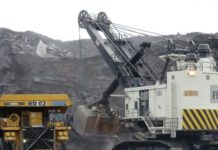[miningmx.com] — BHP Billiton confirmed a months-long outage at the world’s No. 4 copper mine and reported near flat quarterly output of iron ore on Wednesday, placing it even deeper in rival Rio Tinto’s shadow.
BHP’s first 2009/10 forecast for a 5 to 10 percent rise in production at its Escondida copper mine in Chile, the world’s largest, failed to dispel the disappointment over a fall in quarterly copper output and news of force majeure on uranium and copper supplies from its stricken Olympic Dam mine.
The world’s biggest miner said that Olympic Dam — crippled by a runaway skip that took its Clark shaft out of operation on Oct. 6 — is expected to continue running at 25 percent of ore-haulage capacity until full output resumes in the first quarter of next year, confirming expectations of an up to six-month disruption.
The outage has contributed to this month’s rise in copper prices to a more than one-year high of $6,570 a tonne on Tuesday and threatened to further curtail this year’s forecast supply surplus, and will eat into uranium supply from the world’s biggest known deposit of the power plant fuel.
“I have a forecast surplus of over 200,000 tonnes. Obviously this will tighten things up and other cumulative disruption elsewhere might start to take their toll,” said David Moore, commodities strategist at Commonwealth Bank of Australia.
But equity analysts were more put off by BHP’s quarterly production report showing a drop in copper output and meagre 1 percent growth in iron ore. BHP shares dipped nearly 1 percent on Wednesday, and have underperformed Rio for months.
“Most important was the fact that copper was down 8 percent year on year and quarter on quarter,” said DJ Carmichael & Co analyst James Wilson.
Output from Olympic Dam was down even before the shaft damage: maintenance works drove production 31 percent lower to 37,700 tonnes of cathode in the first quarter (July-September) from a year earlier, BHP reported.
A runaway skip, or ore carrier, forced the immediate shutdown of the underground mine’s main haulage system.
BHP said its investigations into the incident was not yet complete, with ore now being hoisted to the surface via its smaller, secondary Whenan shaft, which can handle only about 25 percent of haulage.
On a brighter note, the company said production at its majority-owned Escondida mine in Chile, which has fallen this year due to operational problems at one mill and declining ore quality, was forecast to rise 5-10 percent after repairs to its Laguna Seca mill and higher average grade of copper in the ore.
The first forecast for output in the July 2009 to June 2010 year — which would equate to a roughly 21,000-42,000-tonne rise in output for BHP — comes just a week after union workers at the mine accepted an early wage offer, averting the risk of a strike.
IRON ORE LAGS RIVAL RIO
Although BHP’s near-flat performance in its iron ore segment came in the traditionally high-output period, when the seasonal Pilbara iron ore belt is its driest and mining is least apt to face disruptions from heavy rains and cyclones, BHP said it was due to long-term expansion rather than short-term issues.
Production of 30 million tonnes in the September quarter was 11 percent higher than the previous quarter, due to contributions from its three iron pellet-making plants in Brazil operating under its Samarco partnership with Vale.
“As RGP 4 (rapid growth production 4) is nearing completion, existing operations will continue to be impacted by tie-in activities in the next quarter,” BHP said.
BHP expects the project to add a further 26 million tonnes of capacity by the end of 2009. The fifth step in its phased growth path aims to increase capacity another 50 million tonnes to 205 million tonnes a year in calendar year 2011.
But the year-on-year growth from the world’s No. 3 producer was far short of Rio Tinto’s 12 percent rise in the same quarter. BHP also left its full-year guidance unchanged while Rio upgraded its forecast production by 5-7.5 percent last week.
Shares in BHP have risen just 5 percent this month, half as much as Rio Tinto. Rio shares have more than doubled since January; BHP is up by just 30 percent.
Olympic Dam’s copper is sold in Europe, Australia and Asia under contracts negotiated annually based on monthly LME cash settlement prices. Its uranium is sold in Britain, France, Sweden, Finland, Belgium, Japan, South Korea, Canada, the United States and Spain.
Force majeure notices free a miner from liability if it can’t meet a contract due to events beyond its control.
BHP earlier would only estimate the Clark shaft would be out of commission for at least a month.
Analysts had speculated that repairs could take up to six months and cause the loss of 50,000 tonnes of copper production and 1,000 tonnes of uranium production.











